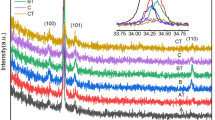Abstract
Recent Mössbauer isomer shift (IS) measurements on119Sn impurities substitutionally implanted in several AIIIBV compounds are interpreted in terms of their electronic structure. Since tin can replace both the A and the B atoms, two different IS lines arise corresponding to the donor and acceptor Sn impurities. To calculate the electronic configuration of ionized tin donors and acceptors and the relevant electron contact densities, a Green-function procedure is used based on the parametrized tight-binding approximation including relativistic wave functions. It turns out that with ionized Sn acceptors, the impurity is formed by a small cluster containing the tin atom in its neutral configuration rather than by a single negative Sn ion as might be anticipated at first sight. On the other hand, in the donor case the positive Sn ion plays the dominant role.
Similar content being viewed by others
References
B.D. Dunlap and G.M. Kalvius, in: Mössbauer isomer shifts, ed. G.K. Shenoy and F.E. Wagner (North-Holland, Amsterdam, 1978) p. 45.
A recent review on Mössbauer IS can be found in Mössbauer isomer shifts (see above).
E. Antoncik, in: Electrons in crystalline solids (IAEA, Vienna, 1973) p. 461.
G. Weyer, A. Nylandsted-Larsen, B.I. Deutch, J.U. Andersen and E. Antoncik, Hyp. Int. 1 (1975) 93. G. Weyer, J.W. Petersen and S. Damgaard, Hyp. Int. 10 (1981) 775.
E. Antoncik, Proc. Int. Conf. on lattice defects in semiconductors, Freiburg, 1974. Inst. Phys. Conf. Ser. No. 23 (London, 1975) p. 565.
E. Antoncik, Hyp. Int. 1 (1976) 329.
E. Antoncik, Hyp. Int. 11 (1981) 265.
E. Antoncik, Phys. Rev. B23 (1981) 6524.
C. Hilsum, in: Physics of semiconductors, ed. M. Hulin (Dunod, Paris, 1964) p. 1127; See also W.A. Harrison, Electronic structure and the properties of solids (Freeman, San Francisco, 1980).
G. Weyer, J.W. Petersen, S. Damgaard, H.L. Nielsen and J. Heinemeier, Phys. Rev. Lett. 44 (1980) 155; G. Weyer, J.W. Petersen and S. Damgaard, in: Proc. of the 12th Int. Conf. on defects in semiconductors, ed. C.A.J. Anmerlaan (North-Holland, Amsterdam, 1982); G. Weyer et al., to be published (1983).
See ref. p. 21.
E. Antoncik, Hyp. Int. 18 (1980) 161; note the misprint in this paper in eq. (3), which should be identical to eq. (24) in ref. [7].
A. Zunger and M.L. Cohen, Phys. Rev. B18 (1978) 5449; Phys. Rev. B20 (1979) 4008.
D.J. Chadi and M.L. Cohen, Phys. Stat. Sel. (b) 68 (1975) 405.
D.J. Chadi, Phys. Rev. B16 (1977) 790.
J.E. Lowther, Phys. Rev. B15 (1977) 928.
E. Antoncik, Phys. Stat. Sol. (b) 79 (1977) 605.
D.A. Liberman, D.T. Cromer and J.T. Waber, Comp. Phys. Com. 2 (1971) 107.
See ref. [8] for more details where, however, slightly different boundary conditions have been used.
B.L. Gu, Ph.D. thesis, University of Aarhus, 1982 (unpublished).
See ref.. eq. (18) for more detail.
The problem of the role of the ionization energies is discussed in detail by A.A. Levin, Quantum chemistry of solids (McGraw-Hill, New York, 1977); See also H.P. Hjalmarson, P. Vogl, D.J. Wolford and J.D. Dow, Phys. Rev. Lett. 44 (1980) 810.
S. Pantelides, Rev. Mod. Phys. 50 (1978) 797.
See ref., sect. V11.
M. Lannoo, Phys. Rev. B10 (1974) 2544.
See e. q., R.A. Smith Semiconductors (University Press, Cambridge, 1959) p. 59.
As this process is more complicated than the β-decay discussed in the previous section, a comment is, perhaps, in order here. The electron capture of113Sb gives rise to a hole in the F shell while the nucleus changes into1∶9Sn nucleus; also in this case, the sudden change of the nuclear charge and the small recoil energy bring about emission of phonons. Moreover, the K-shell vacancy is filled by an electron from a higher shell taking part either in an X-ray emission or in an Auger effect. These processes occur both in the core and in the valence band, however, in slightly different ways. While the rearrangement of the core (including the valence band electrons) proceeds in a similar way as in atoms and the relevant lifetimes are rather short (10−13−10−15s), the relaxation of the holes in the valence band is more complicated. Let us add in this connection that a long-termed existence of tin ions Sn1+, Sn2+, and Sn+, which in general would be possible in the case of free tin atoms, is avoided here due to the complete delocalization of the valence band electrons. It has been shown by E.O. Kane (Phys. Rev. 159 (1967) 624) and by one of the authors (EA) (Czech. J. Phys. B17 (1967) 953) that the lifetime of the holes in the valence band is determined both by the Auger effect and the electron-phonon interaction. It turns out that highly excited holes in the neighbourhood of the bottom of the valence band lose their energy predominantly by Auger transitions, while at lower energies (at the top of the valence band) it is the emission of optical phonons which governs the thermalization of holes. As the slowing-down times of the latter (final) process are of the order of 10−11−10−13s, the total rearrangement of the electron shells around the119Sn nucleus just created occurs in times much shorter compared to the lifetime of the Mössbauer state.
F. Herman, J. Electronics 1 (1955) 103.
E. Antoncik and B.L. Gu, Phys. Stat. Sol. (b) 111 (1982) 261.
Author information
Authors and Affiliations
Rights and permissions
About this article
Cite this article
Antoncik, E., Gu, B.L. On the Mössbauer isomer shift studies of the electronic structure of Sn implanted AIIIBV compounds. Hyperfine Interact 14, 257–269 (1983). https://doi.org/10.1007/BF02043477
Received:
Revised:
Issue Date:
DOI: https://doi.org/10.1007/BF02043477




